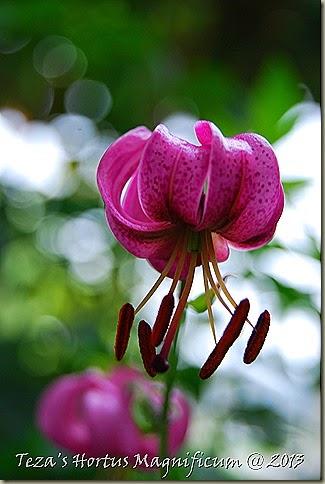Cheryl wanted to know more about Cercidiphyllum japonicum ‘Rotfuchs’ more commonly referred to as ‘Red Fox’ Katsura. My experience with this wonderful cultivar began in a moment of fear, having decided that I simply could not justify the potential of losing a tree, Cercis canadensis ‘Forest Pansy’ due to my own obtuse stubbornness! I’d always wanted one but every time I mustered up the courage, a fellow gardener would shake their head and ask if I was prone to leaving my wallet unattended! ‘You’d be throwing money away! Think of the number of plants you could buy with the cost of that tree!’

Turns out, just as the foliage begins to drop from this amazing genus, it emits a fragrance that is unlike any other. For this reason alone, I was more than intrigued. Imagine having a tree like this in my own yard!

When young, the tree develops an upright, pyramidal silhouette, becoming more broad and rounded as the tree ages. The species type grows 12-15m in height and 7-15m across. Branching remains relatively dense, often with many branching, smooth and muscular branches emanating from the trunk quite low to the ground.
Cercidiphyllum japonicum are either male or female based on the flowers produced each early spring before leaves unfurl. Male trees bear tiny, ribbony green flowers while those of a female plant are red. New leaves emerge bronzy purple and open to a rounded heart shape and a medium green. Female trees can produce seed pods filled with winged fruits. In early autumn,they display yellow to apricot hues on their leaves before they drop. The falling leaves emit a sweet fragrance to the air, similar to spicy warm sugar. The bark is light gray-brown, and as the trunk or branches get larger, the bark flakes and peels in long vertical strips.
This tree is hardy in zones 4 through 8 and where the summers are not too long and hot. It excels in any fertile, moist but well-drained soil that is not too alkaline in pH. Plant the tree in a wind-protected location as drying winds ruin the leaves and cause twig dieback in winter. Water the tree during droughts and since the tree does not transplant well, plant only small saplings so the root system endures minimal root disturbance and re-establishes quickly.
‘Rotfuchs’ is a recent introduction with wonderful, thick rubbery foliage that emerges a rich red purple as noted in the photo above, with delicate golden veins that shimmer when the sun shines through them. It is more columnar in habit, attaining a height of 4m and a spread of 1.5m in a ten year period, making it a perfect specimen for a postage stamp sized property such as my own!
PS: Of course this year I’ve added Cercis canadensis, thanks to the wonderful gifting of one from a friend who seems to have more than he knows what to do with at his parent’s property! Fingers crossed that one day it too will bring me the joy that my ‘Sly Fox’ affords me!
![DSC_0695[7] DSC_0695[7]](https://blogger.googleusercontent.com/img/b/R29vZ2xl/AVvXsEg7CJdKufnBa6yw2WG8cL_cXUMq4pQs_x7JxmdxQg1SPHtUiaW5gDn6QCksKOTdsuHjg1g2GB283dAm9Ig9QLfsvh7bpd4H20AuHVglkQ6Ma2FBvfv_IdvEJYou37hE3nOG4eVZxvDYe1jT/?imgmax=800)

































3 comments:
All of them Cercidiphyllums wonderful trees!
Nothing feels more comforting on a cool late fall day than its cotton candy fragrance. I like it spiced with vanilla from Spiranthes cernua var. odorata.
Gabi
Love it. To satisfy all my garden "needs" I'd require a lot the size of Montreal. Enjoy your foxy lady.
oooooooo Thank you Barry! I love when a plant gives you an unexpected surprise like its fragrance. Cotton candy eh, how delicious is that. Unfortunately it wouldn't do well here as me garden is in a wind tunnel, shady and o so dry. March 31 and I'm actually watering!!! What's wrong with this picture.
Post a Comment